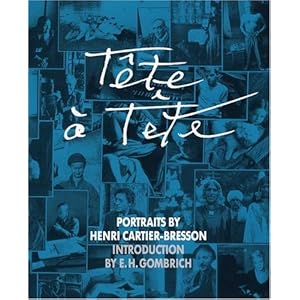
CARTIER-BRESSON, Henri - Palais Royal, Paris, 1960.jpg
John Berger pays tribute to his good friend
The Observer, Sunday 8 August 2004
At every railway crossing in France there is a solid notice, a panel with writing on it which reads: 'Attention! Un train peut en cacher un autre.' Cartier-Bresson, whatever the event he was photographing, saw the second train and was usually able to include it within his frame. I don't think he did this consciously, it was a gift which came to him, and he felt in the depths of his being that gifts should continually be passed on. He photographed the apparently unseen. And when it was there in his photos it was more than visible.
Yesterday he joined the second train. At the age of 95 - with all his agility - he jumped it. He has joined his inspiration. Six years ago he wrote something about inspiration: 'In a world collapsing under the weight of the search for profit, invaded by the insatiable sirens of Techno-science and the greed of Power, by globalisation and the new forms of slavery - beyond all of this, friendship and love exist.' He wrote this in his own handwriting, which was open like a lens which has no shutter.
Bullshit! I now hear him saying, look at my drawings, there is no second train in them! So I look at some reproductions of some of his drawings. How drawings change - even 24 hours after a death; their tentativeness disappears, they become final. He said repeatedly in his later years that photography no longer interested him as much as drawing. Drawing - or anyway drawing as he drew - has less to do with the sense of sight than with the sense of touch, with touching the substance and energy of things, with touching the enigma of life without thinking about eternity or the second train. Drawing is a private act. Yet Cartier-Bresson returned to it, knowing very well that it was an act of solidarity with both those who see the second train and those who don't.
That's better, he says.
An epitaph for him? Yes, a photo he took in Mexico in 1963. It shows a small girl in a deserted street carrying a framed daguerreotype portrait of a beautiful and serene woman which is almost as large as the child. Both are about to disappear behind a tall fence.
The last second of visibility, but not of the woman's serenity or the girl's eagerness.
???
?
Mexico (girl with a magazine), photo by Henri Cartier-Bresson, 1934
Henri Cartier-Bresson - Wikipedia, the free encyclopedia
1998: Tête à tête. Texts by Ernst H. Gombrich. Thames & Hudson, London. French, German, Italian and Portuguese editions

From Amazon
Henri Cartier-Bresson's Tête à Tête contains the photographer's portraits of some of the most potent icons of the latter half of the 20th century. The book is understated, yet powerful and challenging--a masterpiece of the photographer's art of composition and expression. Presented in nonchronological order, yet arranged to provide links and parallels in posture and facial likenesses, familiar icons easily mix with anonymous subjects: a very young Truman Capote in crumpled T-shirt, on the brink of literary fame; a very old Colette, who retains her inquisitorial gaze; Matisse with his birds; Sartre with his pipe; Igor Stravinsky, astonishingly similar in 1946 and 1967; a beaming Che Guevara. There are also group portraits of unknowns, but none the less resonant for that: be suited men in 1950s Iran, tribes people from Kashmir, prostitutes in Mexico, the women of southern Spain, dressed eternally in black. As the art historian E.H. Gombrich comments in his introduction to Tête à Tête, in these portraits Cartier-Bresson moved significantly away from the received techniques of the "society" photographer. Instead, he "always preferred to lie in wait for the telling moment." --Catherine Taylor, Amazon.co.uk
From Library Journal Cartier-Bresson is well known as a master of portrait photography, a visual detective unraveling the mystery of people by revealing so much in his images. Whether his gift is the conscious convergence of people, environments, and light or an amazing coincidence of these elements when he is present, his work is familiar, even comforting. These portraits are how we think of Sartre, Picasso, Sontag, and others. Cartier-Bresson also captures anonymous people who present themselves to his camera with a relaxed honesty of self and spirit. The late art historian E.H. Gombrich's introductory text is respectful, analytical, and a valuable asset to those who will wander through this bound gallery of the photographer's best work. Perhaps the nicest surprise is the inclusion of Cartier-Bresson's pencil drawings, which show the artist's skills in another medium. Recommended.?David Bryant, New Canaan P.L., CT
Copyright 1998 Reed Business Information, Inc.
Tete A Tete [Hardcover] E.H Gombrich (Author) , Henri Cartier-Bresson (Photographer)
- Hardcover: 144 pages
- Publisher: Bulfinch Press UK (Sep 1 1998)
Cartier-Bresson , 1978年不"認識" E.H. Gombrich 可請他為
1978年愛丁堡藝術節的展寫序文. 讀起來更有興味:
Photographer as Artist: Henri Cartier-Bersson
tete-a-tete
- tête-à-tête
- 発音
- téitətéit
[形]2人だけの;差し向かいの;内密の.
━━[名]
2 (2人が互い違いですわる)S字形ソファー.
━━[副]2人だけで;差向いで.
[フランス語=head-to-head]經典http://www.magnumphotos.com/C.aspx?VP3=SearchResult&ALID=2TYRYD1D518O
Book - The Decisive Moment
Henri Cartier-Bresson
Publisher: Editions Verve (Paris, 1952)
French title: Images à la sauvette

Henri Cartier-Bresson 1948
CHINA. Beijing. December 1948. The Forbidden City in the...

Henri Cartier-Bresson 1948
CHINA. Shanghai. December 1948-January 1949. As the value of...

Henri Cartier-Bresson 1948
CHINA. December 1948-January 1949. Shanghai. Suchow creek....

Henri Cartier-Bresson 1948
CHINA. Beijing. December 1948. A few days before the arrival...

Henri Cartier-Bresson 1949
HONG KONG. 1949. It was the day of the Kwantung Handicap -...

Henri Cartier-Bresson 1949
CHINA. Shanghai. June 1949. Two White Russian refugees stand...

Henri Cartier-Bresson 1949
CHINA. Shanghai. June 1949. Communist parade. The banner...

Henri Cartier-Bresson 1949
CHINA. Shanghai. 1949. Students in the August 1st victory...

Henri Cartier-Bresson 1948
CHINA. Beijing. December 1948. A tea-house, before the...

Henri Cartier-Bresson 1949
CHINA. Jiangsu. Nankin. April 1949. A canal that joins the...

Henri Cartier-Bresson 1948
CHINA. Beijing. December 1948. A eunuch of the Imperial...
沒有留言:
張貼留言